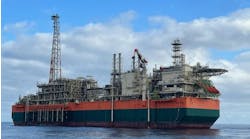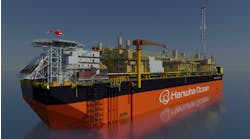GULF OF MEXICO: Reservoir temperatures, low thermal gradient limit US Gulf's deepwater gas potential
Projected natural gas production from known and future discoveries in the deepwater Gulf of Mexico (1995-2010). When new discoveries are included, deepwater gas production grows to 2007-2008, peaking at 3.1 tcf (high case).
Recent discussions on the future of the US energy economy have been dominated by a single vision - the increase in non-transportation energy demand to be supplied by natural gas. In no end-use sector is this pattern more pronounced than electrical generation. Nearly all (95-98%) of US generating capacity anticipated to be installed by 2010 is projected to be fired by natural gas.
The attraction of this vision is easy to understand. Natural gas has long been recognized as the cleanest fossil fuel. Moreover, natural gas-powered generating equipment is now highly thermally efficient, has a relatively low capital cost, and is easy to permit and install. When these substantial advantages are coupled with the promise of plentiful supplies of natural gas at reasonable prices, the combination seems almost too good to be true.
This vision is indeed too good to be true. The National Petroleum Council (NPC) has projected demand for natural gas to increase from 22 tcf in 1998 to 29 tcf or more by 2010. This increase will be supplied almost entirely from three sources: Canada, the Rocky Mountain region, and the deepwater Gulf of Mexico (GOM).
The deepwater Gulf of Mexico is projected to be the most important source of new supply. From 1998 to 2010, annual gas production from this area has been predicted to increase from less than 0.9 tcf to more than 4.5 tcf, supplying more than half of the expected increase in demand.
Emerging evidence from deep-water exploration indicates the projection substantially overstates the gas producing potential of the deepwater Gulf. Although deepwater gas production will increase rapidly to 2007, it is likely to plateau shortly thereafter and at best barely exceed 3.0 tcf per year.
Projecting gas production
Most projections take an abstract, top-down approach. They begin with overall estimates of resource potential and, using abstract analytical constructs such as reserves added per well drilled, eventually arrive at estimated future production. A contrasting point of view is based on a concrete, bottom-up approach. Substantial data exists on deepwater discoveries including:
- Estimated field size by hydrocarbon type
- Projected peak rates of production
- Estimated timing of initial and peak production.
Future production profiles for known deepwater discoveries stem from these data. Other data derived from current deepwater discoveries include:
- Spatial patterns of discovery by field size and hydrocarbon type
- Emerging geochemical evidence
- Discovery sequences by water depth class by field size and hydrocarbon type.
These data are used to estimate the timing and quantity of future discoveries and consequently their production profiles. Adding projected production from both known and projected discoveries provides a defensible outlook for future deepwater production that makes maximum use of the available knowledge on deepwater discoveries.
By the summer of 2000, at least 163 confirmed new field discoveries had been made in the deepwater lease areas of the Gulf of Mexico. Possibly another 5-10 discoveries as yet unconfirmed were made in 1999 and 2000, but these are unconfirmed primarily because they are small- to medium-sized fields.
These discoveries have predominantly been oil discoveries. More than half (83) are oil fields, while less than one-third (52) are gas fields. The remaining 28 have significant proportions of both oil and gas. The dominance of oil fields in deepwater, particularly in the larger fields, is reflected in the composition of estimated ultimate recovery by hydrocarbon type within them.
Current estimates of ultimate recovery by NRG Associates for these fields total 8,725 million bbl of crude oil, 1,425 million bbl of natural gas liquids, and 26.88 tcf of natural gas, or 14.63 billion BOE.
Natural gas provides barely 30% of the discovered deepwater resource. In sharp contrast, gas accounts for 65% of the estimated ultimate recovery on the shallower shelf.
Of these discoveries, nearly half (78) had begun production by 1999. More than 80% of the rest have published indications of their size, production potential, and/or timing of initial and peak production. Operators of nearly all of the few discoveries that lack significant information have indicated the discoveries are small, marginal fields that are unlikely to contribute significantly to future production.
Projected natural gas production from known discoveries in the deepwater Gulf of Mexico (1995-2010). Gas production from known fields peaks in 2006, based on current estimates of ultimate recovery, incorporating reserve growth.
This information provides a detailed foundation for projecting future production from known fields. Production is projected to continue its rapid increase through 2003, peaking that year at 2.03 tcf (5.56 bcf/d). Following that peak, production declines slowly (6-7% per year) through 2006. Nearly all current discoveries will have been brought onstream by 2006, declines will accelerate thereafter.
Current estimates of total recovery from confirmed discoveries provide a conservative estimate of future production potential. Fields grow in size over time. This growth needs to be incorporated in production estimates. Two guidelines were used to estimate future growth in the confirmed deepwater fields:
- Large fields tend to grow larger; small fields shrink or remain unchanged. This rule is based on the observed pattern in deep-water fields the past decade.
- Recent discoveries tend to grow more than established producing fields.
Future growth ranging from 5% to 100% over current estimates were projected for 75 of the confirmed fields using these two guidelines. With this growth, total estimated ultimate recovery from the 163 confirmed fields is indicated at 11.2 billion bbl of crude oil, 1.85 billion bbl of natural gas liquids, and 33.51 tcf of natural gas, or 18.64 billion BOE (27% greater than the current estimate).
Like production without growth, production with growth also peaks in 2003, but at a significantly higher level (2.41 tcf or 6.61 bcf/d). Because the effects of growth on production occur primarily from 2002 to 2007, production with growth declines initially at slower rates before accelerating in the last few years of the decade as the effects of growth are gradually exhausted.
Low thermal gradient
The deepwater is a highly active exploration area. Future gas production, particularly at the end of this decade, will depend heavily on new discoveries. Instead of making arbitrary assumptions about the number, size, and hydrocarbon type of future discoveries, this analysis is based on three key observations on the type, rate, and size distributions of recent deepwater discoveries.
The first key observation is that the deepwater GOM is an oil-prone area, unlike the gas-prone adjacent shelf. The oil-prone quality stems from two interrelated factors:
- The source rock for most of the deepwater area is an oil-prone source of Upper Jurassic Oxfordian age with type II-S kerogen. This source generates substantial quantities of natural gas only when subject to very high temperatures.
- Most of the deepwater area in the GOM is unusually cool. Reservoir temperatures at 25,000 ft below sea level over the majority of the deepwater area are only 200-300
The unusually cool temperatures of most deepwater reservoirs are the result of near-freezing temperatures at the mudline (the base of the water column) and low thermal gradients (1.0-1.25
Distributed heat flow
Gas discoveries in the deepwater Gulf of Mexico reflect the spatial distribution of heat flow across the deepwater area. Deepwater gas discoveries are highly concentrated in the upper slope (less than 800 meters water depth) and in the two areas of high heat flow in deeper waters (the eastern half of the Mississippi Canyon area and the western two-thirds of the East Breaks area). These are the only areas where either optimal rates of biogenic gas generation or thermogenic gas generation is likely to occur.
The second key observation is that the rate of new field discoveries in the deepwater GOM has accelerated. Half of all confirmed deepwater discoveries occurred from 1995 to 2000. From 1995 to 1999, an average of 15 discoveries was made per year. This acceleration is a consequence of four factors:
- Deepwater drilling technologies have progressed so that deepwater out to 2,500 meter water depth can now be drilled.
- There are more deepwater rigs.
- The large number of deepwater developments have made nearby small prospects economically viable exploration targets (which can now be produced by subsea completions tied back to larger producing facilities).
A fourth factor is the fact that gas discoveries in deepwater are disproportionately smaller than oil discoveries. None of the thirty largest deepwater discoveries to date is predominantly a gas field. Only six of the fifty largest discoveries are gas fields.
Although the rate of gas discoveries also has accelerated recently, most of these discoveries are small fields with less than 150 bcf recoverable reserves. The smaller average size of deepwater gas discoveries is likely a consequence of their concentration on the upper slope where reservoirs are both thinner and less continuous.
Given these facts, most of the gas that will be discovered in deepwater will be casinghead gas produced with crude oil. The major uncertainties are thus what the amount of crude oil discovered will be and what its average marketable gas-oil ratio (that is, after liquids extraction) will be. This paper uses two cases:
- A low case of 1.0 billion bbl discovered annually from 2001 to 2004 and declining slowly thereafter with a gas-oil ratio (GOR) of 1,200 cu ft/bbl
- A high case of 1.2 billion bbl discovered annually from 2001 to 2004 and declining slowly thereafter with a GOR of 1,500 cu ft /bbl.
Eight gas discoveries are assumed to be made each year from 2001 to 2004, four small fields averaging 50 bcf, two medium sized fields averaging 125 bcf, and two large fields averaging 300 bcf. The number of these discoveries subsequently declines slowly through 2010. The total number of oil and gas discoveries is estimated to be 20-25 per year. Small discoveries are assumed to begin production 1-3 years after discovery. Larger discoveries are assumed to begin production 3-5 years after discovery.
These assumptions result in a near doubling of discovered Gulf of Mexico petroleum resources through 2010. The estimated range of recoverable resources associated with the two cases is 26.6 billion BOE (low case) to 34.0 billion BOE (high case). Discovered gas resources range from 45.7 tcf to 56.2 tcf.
These estimates of future discoveries significantly alter the projection of future deepwater gas production. When the effect of new discoveries is included, deepwater gas production continues to grow to 2007-2008, peaking at nearly 2.5 tcf in the low case and at 3.1 tcf in the high case.
However, the lack of giant gas discoveries means that gas will not be discovered in sufficient amounts to increase production beyond these levels. As the average size of deepwater discoveries decreases, gas production begins to decline by 2010.
Implications
Through 2006, deepwater gas production should increase rapidly, supplying a substantial proportion of growing US gas demand. However, if domestic gas demand grows after that, the increments in demand must be met by other sources of supply. However, other sources of gas supply are also problematic:
- Conventional gas production onshore and on the Gulf of Mexico shelf is likely to be much lower than what most projections assume because of unrealistic expectations regarding the potential for new field discoveries.
- Coalbed methane production from the Piceance (Colorado) and Uinta (Utah) basins will likely be substantially less than has been projected.
- Canada may be unable to increase gas exports to the US and still meet growing internal demand. Including the deepwater, US gas supply by 2010 could be 3-4 tcf less than anticipated.
If US electrical demand continues to grow, the electrical generating industry will have to look to other primary energy sources to supply demand. Moreover, because of the larger lead times in planning, permitting, and installing such facilities, they will have to do so in the next year or two, if the US economy is not to be constrained by a lack of electrical power in the latter years of this decade.





